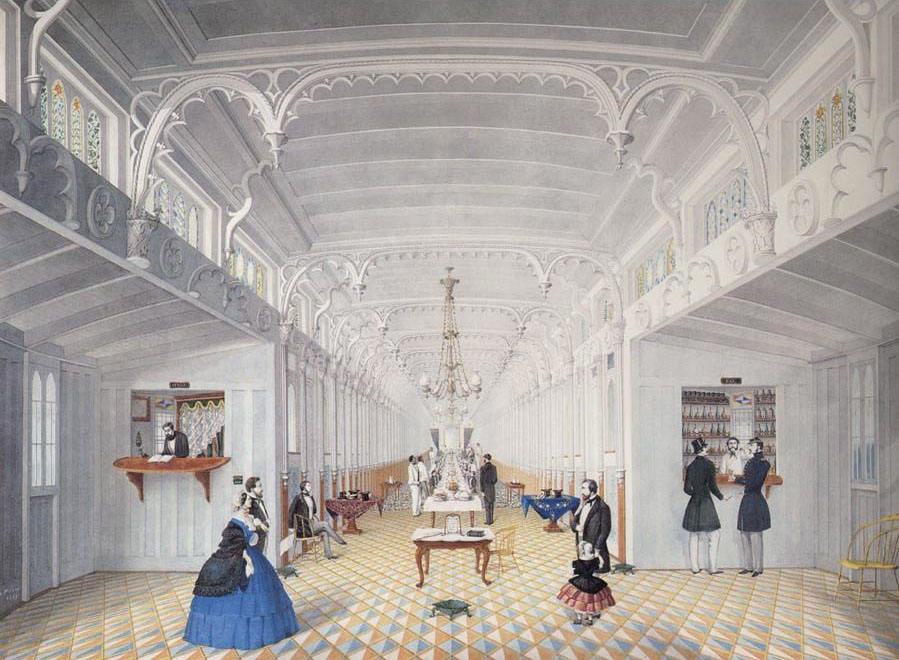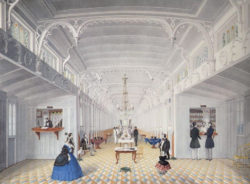Steamboat Princess Disaster
On February 27, 1859, the Steamboat Princess exploded on the Mississippi River killing between 70 and 200 passengers and crew.

Courtesy of The Historic New Orleans Collection
Steamboat Princess. Persac, Marie Adrien (Artist)
Robert Fulton’s steamboat is arguably the single most important invention that spawned settlement and economic expansion in nineteenth-century Louisiana. On a landscape lacking roads but braided with bayous and rivers, travel via water was the only efficient means of transportation. By eliminating the manpower required to row or paddle, often against powerful currents, steamboats fueled an exponential growth in trade and development. However, they were not without hazards, as high-pressure steam boilers manufactured according to the science of the day were analogous to kegs of dynamite. Steamboat explosions were dramatic, deadly, and common. In the thirty years prior to the Civil War, several thousand lives were lost in steamboat calamities. The disaster of the Princess near Baton Rouge in 1859 was a tragically typical example.
The Boat
In 1859 the Princess was a four-year-old state-of-the-art side-wheel paddleboat. A sister boat to the famous Natchez, the Princess had undergone a thorough retrofitting the previous summer and was said to be one of the fastest and most luxurious craft on the Mississippi River. Lavish meals were served four times a day in a great central hall, and surviving menus list such gourmet delicacies as broiled pompano and stuffed crabs. Its clientele were among society’s elite in the Lower Mississippi Valley. The Princess ran weekly round trips from New Orleans to Vicksburg, Mississippi and back, departing the New Orleans wharf promptly at 5 p.m. every Tuesday. On the three-hundred-mile upriver leg, it made stops at Donaldsonville, Plaquemine, Baton Rouge, Port Hudson, Bayou Sara, Red River Landing, Fort Adams, Natchez, Waterproof, Rodney, St. Joseph, Grand Gulf, and Warrenton, before arriving at Vicksburg. The stops were reversed on the downstream journey as passengers, mail, and tons of freight including four-hundred-pound bales of cotton were loaded and unloaded.
Disaster
Maintaining a posted schedule was important in the competitive business of steamboat commerce. When the Princess pulled up to the wharf in Baton Rouge early on the morning of February 27, 1859, it was already late. The boat was loaded with passengers, mostly from Mississippi and Louisiana, headed to New Orleans to celebrate Mardi Gras. More passengers boarded at Baton Rouge including a number of politicians fresh from the state legislative session that had just ended early for the holiday. An estimated four hundred people were on board the Princess when it pulled out into the current of the river after 9 a.m. Because the boat was late, high boiler pressure had been maintained during the stop, and second engineer Peter Hersey was reported to have declared that he would make it to New Orleans on time “if he had to blow her up.” As a portent of the looming catastrophe, the Mississippi River was veiled in a dense fog.
The Princess was about six miles below Baton Rouge at Conrad’s Point when a teenage boy watching the boat glide along from a distance noted, “A great column of white smoke suddenly went up from her and she burst into flames.” The explosion was cataclysmic as all four huge boilers burst at once. Hersey and many others died instantly in a blast of scalding steam. Concussion swept away the infrastructure, and the upper cabins, state rooms, and hurricane deck collapsed inward. Fire broke out and began to consume the remains.
Even amid the horrendous chaos, rescue efforts began immediately. The flaming hull drifted onto a shoreline sandbar and grounded. Uninjured crewmen and passengers dragged the injured up onto the sandbar. Slaves from the nearby Cottage plantation were ordered to bring sheets and blankets. Barrels of flour were emptied on the ground, and the terribly burned victims were rolled in it and placed in the shade. Men in skiffs from both riverbanks rescued people clinging to debris. Plowing upriver from New Orleans, the Natchez was the first steamboat to arrive on the scene. For several hours its crew and passengers provided aid before heading upriver, its decks covered with bodies of the dead and injured.
There was no manifest to record the names of passengers aboard the Princess at the time of the disaster. The number of people killed instantly or who drowned or died as a result of their injuries was variously estimated from seventy to two hundred; the actual number was likely closer to the smaller figure. At least a hundred people survived their injuries. Among those killed were Louisiana state representatives H. J. Huard and Charles Bannister. The boat and its entire cargo was a total loss. Human error—failure to maintain safe boiler pressure—was determined to be the cause of the tragedy, and a pall was cast over the 1859 Mardi Gras celebrations.
